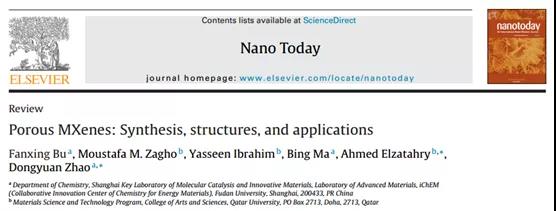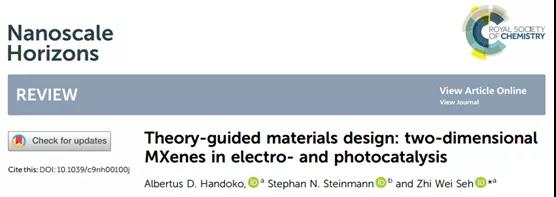What are the overviews of MXene materials in 2019 worth seeing?
QQ Academic Group: 1092348845
Detailed
As a new two-dimensional material, MXenes material has received extensive attention in the fields of electrochemical energy storage, catalysis, electromagnetic shielding and biomedicine due to its unique properties. The article hopes to provide some reference for everyone‘s future research.
【Two-dimensional materials and energy storage】

Professor Wang Guoxiu of the University of Science and Technology of Sydney, Liu Hao‘s group and Shanghai University‘s Wu Minghong‘s group published a review in the internationally renowned academic journal Small, and looked forward to the further research of 2D MXenes in the field of energy storage from the following aspects.
Reduce the thickness of 2D materials as much as possible through efficient stripping technology;
The improvement of morphology has a very important role in increasing the number of active sites. Therefore, controlling the porosity and degree of bending of 2D nanomaterials can result in a higher specific surface area and pore volume, which will enhance storage in supercapacitors and rechargeable batteries. Performance in application.
For lithium-ion batteries and sodium-ion batteries, if the electrode material is free of defects or functional groups, it will greatly reduce the initial Coulomb efficiency.
【MXenes • Energy Storage】

Professor Zhang Wenkui and Professor Xia Yang of Zhejiang University of Technology published a review in the internationally renowned academic journal ChemSusChem, and summarized from the perspective of MXenes interface structure design and functional processing: (1) High-quality MXene materials with large size sheets with nano-scale defects The exploration of mild and safe etching conditions also needs to consider factors such as low cost and high output, which has far-reaching significance for industrial production. (2) The interrelationships and interactions between the functional groups of MXene (such as -O, -OH, and -F) and their effects on electrochemical performance are still in the cognitive stage, which requires in-depth systematic research. (3) The chemical and thermal stability of MXene may have a huge impact on its energy storage behavior, and further research is needed in this regard.
[MXenes • Applications in Environmental Related Fields]

Prof. Zhimei Sun‘s group from Beijing University of Aeronautics and Astronautics published a review on NanoscaleHorizons, an internationally renowned academic journal, summarizing the related applications of MXenes materials in the fields of synthesis, performance and environment, and summarized them from the following three aspects:
From the perspective of synthesis: (1) Some MXenes such as Sc2C, Hf2C, W2C, etc. have been theoretically proven to be stable, but their precursors have not been successfully prepared. Therefore, new MAX phase materials or precursors of other layered carbide nitrides are important for expanding the MXene material system. (2) Applying new methods to prepare high-quality MXenes with large lateral size, few defects, and controllable surface functional groups is still an urgent problem to be solved.
From the perspective of performance investigation, some conclusions obtained through theoretical calculations have not been verified experimentally, especially the semiconductor nature of MXene. At the same time, there is currently no research on the experimental measurement of the band structure of MXene, which is very important for understanding the basic performance of MXenes. The analysis of the structure and properties of various intercalated ions and complexes of MXenes should be further studied.
From an application point of view, although MXenes has very outstanding performance in many application fields, its physical mechanism still needs in-depth research. For example, the understanding of catalytic and electrocatalytic performance of various MXene-based materials can provide new ideas for designing new high-tech catalysts. The mechanism of MXene‘s high sensitivity to NH3 has not been theoretically explained, which limits the application of MXenes-based materials in gas sensors.
【MXenes • Synthesis, Structure and Application】

Fudan University Academician Zhao Dongyuan‘s team published a review article in the internationally renowned academic journal Nano Today. The article summarized the main synthesis methods of porous structures MXenes in the past three years and their applications in tritium capacitors, lithium / sodium ion batteries, lithium sulfur batteries, electromagnetic shielding and absorption, Applications in piezoresistive sensors and cancer treatment are summarized, and the formation mechanism of porous structures in different fields is analyzed.
Future research directions:
i) How to prepare ordered porous MXenes with highly controlled pore size and structure?
ii) How to simultaneously optimize the composition and structure of porous MXenes?
iii) The rich defects and functional groups on the surface of MXenes nanosheets make the porous structure an ideal substrate for supporting other functional materials, such as monoatomic catalysts. Therefore, MXene-based porous composites still need further research;
iv) Explore the possibilities of other potential applications for porous MXenes.
【MXenes • Lithium Sulfur Battery】

Dr. Ruihu Wang from the Fujian Institute of Research on the Structure of Matter of the Chinese Academy of Sciences published a review in the internationally renowned academic journal Journal of Materials Chemistry A, summarizing the current research status of MXene lithium sulfur batteries. The earth suppresses the shuttle effect and accelerates the use of sulfur. Therefore, even in the case of high sulfur loading, high discharge capacity, rate performance and cycle stability can be obtained. Although considerable achievements have been made in lithium-ion batteries, there are still some inherent problems that need to be further addressed to improve the electrochemical performance of lithium-ion batteries.
【MXenes • Surface Modification】

Professor Nan Qingyu‘s team from Nanyang Technological University of Singapore published a review in the internationally renowned academic journal Small, summarizing the interface modification methods of MXene-based materials and the role of various functional groups on the surface, which has a reference significance for the rational design of MXene surface functional groups.
The -F functional group on the surface is the dominant molecule of MXene, the -OH functional group can adsorb water molecules, and the -O functional group will increase with time, which is consistent with the results of theoretical simulation.
【MXenes • Electrocatalysis and Photocatalysis】

The Singapore Science and Technology Research Institute‘s Zhi Wei She team published a review article in the internationally renowned academic journal Nanoscale Horizons, summarizing the application of two-dimensional MXenes materials in the fields of electrocatalysis and photocatalysis from the perspective of theoretically guided material design, and applied MXene materials to catalysis The future research direction of the field is prospected.
DOI: 10.1039 / c9nh00100j
Related literature links:
1.Nanoengineering of 2D MXene-Based Materials for Energy Storage Applications.
DOI: 10.1002 / smll.201902085
2.2 DMXene-based Energy Storage Materials: Interfacial Structure Design and Functionalization.
DOI: 10.1002 / cssc.201902537
3. MXene and MXene-based composites: synthesis, properties and environment-related applications.
DOI: 10.1039 / c9nh00571d
4. Porous MXenes: Synthesis, structures, and applications
https://doi.org/10.1016/j.nantod.2019.100803
5. MXene-engineered lithium–sulfur batteries
DOI: 10.1039 / c9ta08600e
6.Surface Modifed MXene-Based Nanocomposites for Electrochemical Energy Conversion and Storage
DOI: 10.1002 / smll.201901503
7. Theory-guided materials design: two-dimensional MXenes in electro- and photocatalysis
DOI: 10.1039 / c9nh00100j
- Previous: MXene Ti3C2 / Ti3C2 MX
- Next: 1


 About us
About us